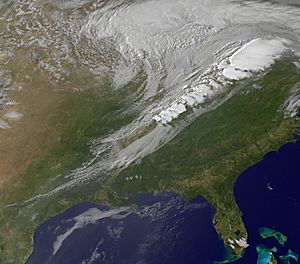Cold front facts for kids
A cold front is a meteorological word that is used to describe the movement of a cooler air mass into an area of warmer air. The air with greater density moves under the less dense warmer air, lifting it, which can cause a line of showers and thunderstorms, or a squall line to form when there is sufficient moisture. This upward motion causes lowered pressure along the cold front. Cold fronts can also move up to twice as fast as warm fronts.
Development of cold fronts
The cooler and denser air wedges under the less-dense warmer air, lifting it. This upward motion causes lowered pressure along the cold front and can cause the formation of a narrow line of showers and thunderstorms when enough moisture is present. On weather maps, the surface position of the cold front is marked with the symbol of a blue line of triangles/spikes (pips) pointing in the direction of travel.
Images for kids
-
A cold front as it appeared on the National Weather Service Wichita, Kansas WSR-88D on April 3, 2011. The thin blue line labeled "cold front" is the front, with severe thunderstorms seen developing behind the front, which is moving towards the bottom right.





